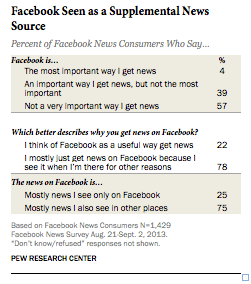
Friends, Followers and Feeds: How news flows on Facebook
Photo credit: Flickr user Johan Larsson
One in three Americans consumes news on Facebook. That’s a noteworthy news flash, even for those accustomed to constant declarations about how the social Web is changing people’s media habits.
A new survey conducted by the Pew Research Center, with support from Knight Foundation, finds that 64 percent of U.S. adults use Facebook, and about half of those users (47 percent) “ever” get news there. This translates to 30 percent of all adults in the United States. What do the results mean for every online news organization seeking to produce shareable content that’s widely distributed?
Here are some of the instructive insights behind the big numbers:
Connect with younger, engaged news consumers. News organizations looking to reach younger audiences need to pay attention to Facebook. The average adult news consumer on Facebook is 39 years old, nearly 20 years younger than the average profiles of people who often read print newspapers and watch cable news. Individuals ages 18-29 represent about a third of Facebook news consumers and are as engaged, if not more so, with news on the site than older Facebook news consumers. Data in other Pew research show that’s not the case on other platforms. “Even when young people do get news on other platforms, they tend to be less engaged with that news than older Americans,” the study says.
Maximize incidental contact. Facebook exposes people to news who are not actively seeking it. The vast majority of Facebook news consumers (78 percent) encounter news when they are on the platform for other reasons, such as seeing what friends and family are doing and looking at photos. When asked about their main reasons for logging in, only 16 percent of all people on Facebook say it’s “to get news.” Facebook allows for some serendipity, a quality not found often on other news sites.
Focus on serious (local) content. News organizations are well positioned to tap into the preferences of people who get news on Facebook. “Entertainment” is the news topic most regularly viewed by 73 percent of Facebook news consumers. But this is closely followed by news topics about “events in one’s own community” (65 percent). “National politics and government” ranks fourth, reaching 55 percent of news consumers, closely behind sports (57 percent). News organizations shouldn’t be suckered into the misconception that only pop culture and celebrities make for compelling social media content. Often the most widely shared viral articles are about serious news and events.
Recognize that topic beats brand. To do well on Facebook, news outlets should worry about the headline more than the display of their brand. The vast majority (70 percent) cite interest in a story’s topic as the biggest single reason for clicking on news-related links. That the link came from a news organization they preferred was only referenced by just 20 percent as a major reason for clicking; that’s well below whether the topic was surprising, something they were following or recommended by a friend. For emerging news organizations, their brand awareness will seldom be a barrier to shareable success on social media. Indeed, many media startups have had success by focusing on creating headlines that are unexpected and pique curiosity.
Nurture lurkers into becoming followers. Facebook followers of news organizations have a much higher level of engagement compared to other news consumers. Only about a third of people who get news on Facebook “like” or directly follow a news organizations or individual journalists. But those who do are nearly three times as likely to click on news links (27 percent versus 10 percent) and twice as likely to post or share stories (16 percent versus 7 percent). The trick for news organizations is how to change the passive discoverer into the committed follower of their news content on Facebook.
Facebook is not going to replace destination online news sites anytime soon. Most Facebook news consumers – 75 percent – say the news they get on Facebook is news they have been exposed to elsewhere. In fact, 39 percent say they view Facebook as an important — but not the most important — source. That creates an opportunity for news organizations. Outreach on Facebook offers access to an audience that otherwise might not encounter their content, and provides extra value to those efforts.
Michael Maness, vice president of journalism and media innovation, and Mayur Patel, vice president of strategy and assessment at Knight Foundation
Recent Content
-
Journalismarticle ·
-
Journalismarticle ·
-
Journalismarticle ·






